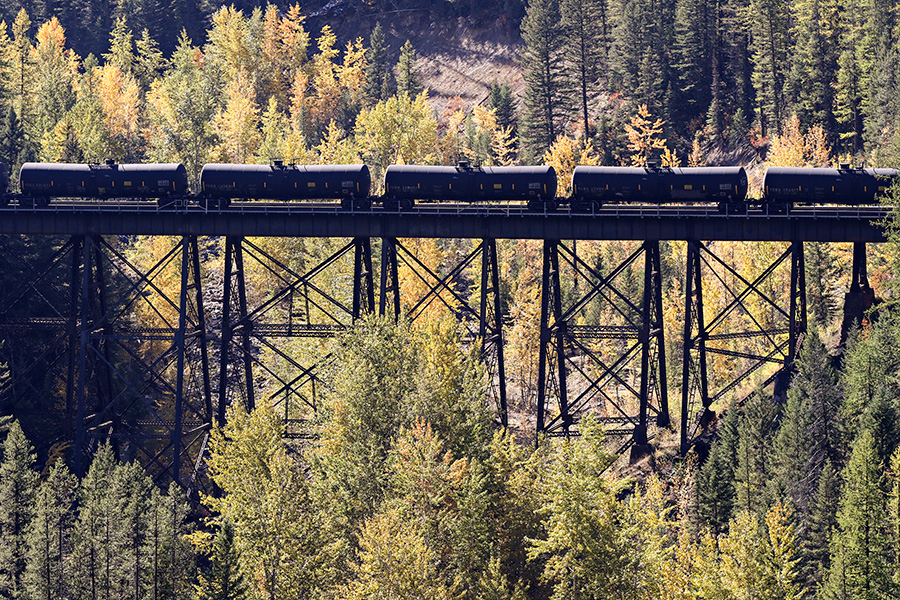For more than a century, westbound freight trains have rumbled up and over the Continental Divide at Marias Pass, tracking along Glacier National Park’s southern boundary and rolling through the meandering Middle Fork Flathead River corridor.
With the oil boom in North Dakota and eastern Montana, however, local and national stakeholders say the potential of train car derailments has gained greater urgency in the region, and are publicly raising concerns about the consequences of a potential “calamity” that could have a devastating impact on a prized watershed.
Last year, the Washington, D.C.-based environmental group American Rivers named the Middle Fork among the nation’s most endangered waterways due to potentially catastrophic threats presented by the increased volume of trains carrying combustible oil, warning that an accident could lead to severe spills and explosions.
Most recently, local sportsmen and women, along with businesses and conservationists, have brought added attention to the potential threat by publishing a brochure highlighting the risk to the Middle Fork, as well as to Whitefish Lake and Flathead Lake. The brochure specifically calls on BNSF Railway, which transports crude through the Middle Fork corridor to ports on the West Coast, to do more to ensure safety on its railway.
Distributed to businesses throughout the valley, the brochure highlights accidents that have occurred across the country in recent years, including one last month in Iowa, in which 230,000 gallons of oil spilled into the Little Rock River when a BNSF train derailed, prompting the governor to issue a disaster proclamation.
“Not a matter of ‘if’ but ‘when’,” the brochure proclaims.
“Flathead Lake is one of the most priceless lakes in the world. If we had an entire 80-car train go into the Middle Fork it would be a disaster beyond belief,” according to Jack Stanford, emeritus director of the Flathead Lake Biological Station, who is featured in the brochure.
Officials with BNSF Railway, meanwhile, have said they are doing everything they can to ensure the safe movement of oil through Northwest Montana, an undertaking that has increased dramatically in response to the Bakken oil boom.
Ross Lane, public affairs director for BNSF, said the railway has a corridor-specific plan in place called a Geographic Response Plan. BNSF has also strategically placed thousands of feet of boom, oil skimmers and other emergency equipment, and conducts twice the amount of track inspections required by the Federal Railroad Administration.
BNSF also strongly defends its safety record, and officials said they are taking steps to continue ensuring the safe movement of oil. The railroad currently runs 10 to 18 oil trains through Northwest Montana every week, according to Lane. Although BNSF does not own the tank cars used to ship crude oil on its network, the railroad has worked with its customers to incentivize them to move away from legacy DOT-111 tank cars. There are currently no DOT-111 tank cars in crude oil service in the railroad’s network.
The railroad highlighted its maintenance program, saying it has spent $850 million in its tracks in Montana in the past five years to improve infrastructure, reduce risk and leverage new technology. This year, BNSF announced a $135 million plan focused on maintaining existing infrastructure. The railroad has also increased the number of defect detectors — a trackside installation that can determine if a passing rail car is malfunctioning — along the Middle Fork canyon. BNSF also operates the loaded oil trains at slower speeds and has increased the number of track inspections in the area.
The railroad also touts its avalanche safety program in John F. Stevens Canyon and its work with avalanche forecasters to predict when slides may impact the rails and when operations should be curtailed.
The railroad has also installed equipment to respond to an incident should an oil train derail and catch fire, including thousands of feet of containment boom to contain oil should it enter the river.
But the business owners and conservation groups behind the brochure say BNSF hasn’t been transparent about its response plan and the public hasn’t had the opportunity to review or comment on it.
“We deserve an open discussion to prevent and mitigate the risk of potential oil train derailments,” Steve Rosse, president of the conservation group Flathead Lakers, said.
Greg McCormick, also of Flathead Lakers, said the risk oil trains pose to the Flathead River system and Flathead Lake is elevated during winter months when the threat of avalanches arises.
“We believe stringent safety and derailment prevention measures are essential for protecting our valuable waters from an oil train disaster in the steep and winding river corridor prone to avalanches,” McCormick said.
Kascie Herron, conservation associate for the Northern Rockies chapter of American Rivers, said the Middle Fork Flathead River was among the inspirations for the Wild and Scenic Rivers Act of 1968, which furnishes protections on the Flathead’s three forks through a federal designation.
To honor the act’s 50-year milestone in 2018, Herron said the need for strong stewardship has never been more pressing.
“A publicly vetted spill prevention plan for the Middle Fork Flathead River is needed,” Herron said. “As we celebrate the 50th anniversary of the Wild and Scenic River Act this year, and the Middle Fork’s status as a federally protected river, hazardous material spills are an even bigger concern.”
Local outdoor industry businesses are raising concerns as well, and Hillary Hutcheson, a fly-fishing guide and the owner of Lary’s Fly and Supply in Columbia Falls, is featured prominently on the brochure.
“Clean water runs through the heart of our business,” she’s quoted saying in the brochure.
